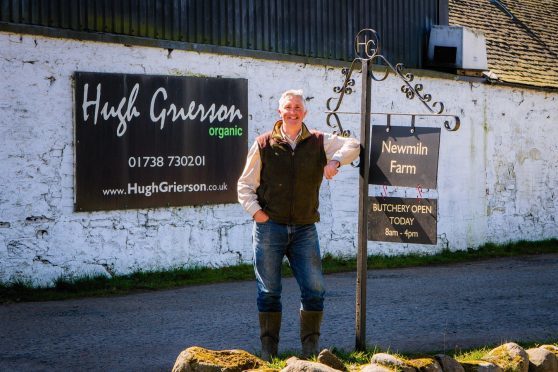Organic farmer Hugh Grierson believes that a long-term trend of people becoming more diet conscious and prepared to pay a bit extra to safeguard their health will secure the future of his business, Hugh Grierson Organics at Newmiln Farm, Tibbermore.
He and wife Sascha have been farming organically for about 16 years now and have developed both a range of products and a customer base which means they have a ready demand for everything they produce.
The majority of the 1,100 acres at Newmiln and Blackruthven is down to grass to support the 110-strong Aberdeen-Angus suckler herd and 400 Easycare ewes. However wheat and oats are also grown – traditionally spring sown to prevent a build-up of weeds, but last year Hugh successfully grew some winter wheat which achieved better yields.
The wheat is all used for feeding in the 12,000-bird free-range, organic egg unit and also the Hubbard broiler enterprise. The slow-growing Hubbard strain of table birds are specifically designed to do well on an outdoor system. They finish at 10 to 13 weeks instead of the five to six weeks a commercial broiler takes, and Sascha believes the difference in flavour and texture is remarkable. She now finishes around 200 per week, which are sold in their own and other farm shops, farmers markets and through the website.
Eggs are sold through Waitrose and their own shop and the dung from both poultry enterprises is spread back on the arable land, completing the management circle. They also have nine black Berkshire sows and finish 100 Devon bronze turkeys for Christmas.
With a full-time butcher working on the farm, the Griersons are conscious that they need enough produce to keep him busy. Also their customers expect the same variety of products they would get from a high street butcher. Hugh said, “We put about 65 to 70 cattle plus nearly 500 lambs and about 70 pigs a year through the butchery, while mutton, chicken and turkeys are all popular with our customers.”
The main marketing tool is the website, which they upgraded recently and keep up to date with news, products and recipes and the vast majority of produce is sold direct to the customer, whether it be small retail outlets, restaurants or individuals who prefer to buy organic.
Hugh said: “Customers usually come to us for one of three reasons – organic for the health benefits, local because they like buying direct from the farm or quality for the flavour. Not surprisingly, we have many repeat customers.”
Explaining his original decision to farm organically, Hugh said: “I grew up on the farm with a passion for wildlife and I wanted to manage my land in a way which would not only make me a living, but also provide a sustainable environment for livestock and wildlife.”
He continued: “Being organic has lived up to expectations, with huge increases in wildlife, especially insects and amphibians. We are committed to staying organic. For me it is about managing my land the way I want and for Sascha it is about great tasting produce.”
In the last few months the Griersons have gone one step further by becoming the only Scottish farm certified with the Pasture Fed Livestock Association. This means their sheep and cattle are reared entirely from grass and forage products, which studies have shown has a positive impact on the environment as well as increasing levels of healthy Omega 3 fatty acid in the meat.
Hugh said that they have had a lot of inquiries from customers about how their beef and lamb is fed and said: “People are concerned about cattle in particular being fed high quantities of grain and soya. I see this as a positive step for our business by adding value to an already organic product without increasing cost.”
